BY JEANNE DORIN MCDOWELL
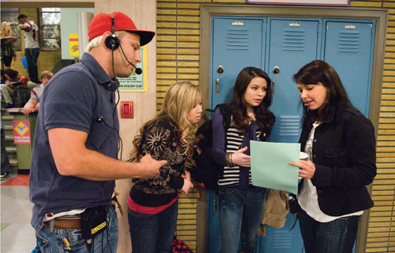 2nd AD Mike Caron gets Jennette McCurdy and Miranda Coscgrove ready
2nd AD Mike Caron gets Jennette McCurdy and Miranda Coscgrove ready
for class with 1st AD Teri Pensky on iCarly. (Credit: Lisa Rose/Nickelodeon)
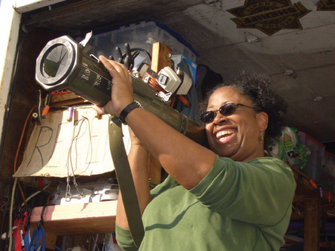
1st AD Victoria Rhodes looks out for her kids on Everybody
Hates Chris. (Credit: Mark Doering-Powell)
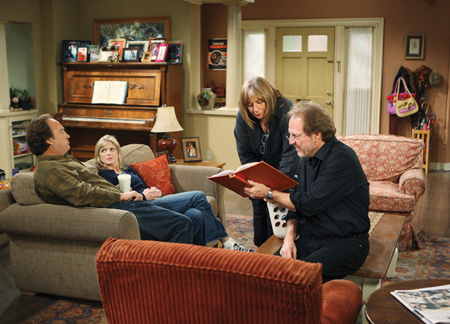
1st AD Dennis Capps with director Penny Marshall and cast on
According to Jim. (Credit: ABC/Michael Ansell)
Dennis Capps knew he was going to have a hard time persuading 6-year-old Conner Rayburn to wear a Cinderella costume. The 1st assistant director on ABC's According to Jim, which wrapped its eighth and final season this spring, was charged with handling the kids on the series, and he was no rookie at it. But dressing up as Cinderella for a Halloween episode didn't sit right with Conner, and the pint-size thespian dug in his heels. "It was like putting a horse around a rattlesnake," recalls Capps.
"I tried to cajole him, but you can't force a kid to do something or they get really upset."
The art of persuasion isn't easy when the target in question is under 10 years old. But when he also happens to be a working actor and delivering his lines is essential for a TV episode, the stakes are high and failure is not an option. As it is, 1st and 2nd ADs' responsibilities are pretty extensive: coordinating with directors, producers, writers and actors, putting schedules together and making sure wardrobe and props are ready. As many shows employ guest directors, it's the ADs who provide continuity for the director on the set. And given that they have long-term relationships with the kids, it's the ADs who typically oversee the care and handling of the children in the cast, ensuring that they are professionally, emotionally and physically prepared to perform their jobs. While the director and executive producer know when a child has to be on a set or leave for schooling, it's the ADs who make it happen.
It's a skill set that calls for psychological awareness, patience, kindness and cunning. Cajoling, convincing, supporting, under-standing, strategically "guiding"—even surrogate parenting—also go along with the job. There are days filled with slip-ups, meltdowns, hormonal imbalances and hovering stage parents. And then there are days when the affection felt for a young actor is tantamount to that of a proud parent.
"We're the first person they see in the morning on the set and the last person they see before they go home," says Mike Caron, 2nd AD on the Nickelodeon hit iCarly, whose star Miranda Cosgrove is now 16. "They're still kids and want to have fun and play. But they have to recognize they're being paid well to do a job." Adds Annie Simons, a 2nd AD on the Disney Channel hit Hannah Montana, "I've watched these kids grow up. One day they're wearing retainers and braces and the next they're driving themselves to work. It's crazy."
Whether they are toddlers or teens, the biggest challenge for ADs is scheduling. Under federal labor law, a child younger than 16 can't be on a set for more than 9.5 hours a day, including 3 hours of school, an hour for lunch and rehearsal time. At 17, they can work for 10.5 hours a day. Most days entail nonstop shuttling between the set and classroom, and sometimes even plucking an actor out of class for 20 minutes to re-shoot a scene, then taking him back to school. It can be disruptive for sure, but there's no other way to work it. And because production doesn't always run on time and directors may be delayed, their assistant directors are inevitably scrambling to get the kids where they need to be. On iCarly, for example, the scripts are long and full of stunts, animal acts and special effects. "You're always up against the clock," says the show's 1st AD Teri Pensky. "You have to know how to have a good time but keep things moving at a super accelerated pace. Kids need rehearsals and they have to learn blocking. And everyone has to know their lines because we move at such a fast pace."
Fast pace doesn't even begin to describe the complexities of shooting Hannah Montana, where the show's star Miley Cyrus not only appears in virtually every scene and has extensive wardrobe changes that transform her from Miley Stewart to the pop star Hannah Montana, but also has hundreds of concert dates and outside commitments. When the show premiered, Miley was an unknown 12-year-old. Today, at 17, she's a global pop icon. By all accounts, Miley is a pro who's ready to work and also an ace student. But the series' ADs make it all happen by banking Miley's hours. In other words, Miley, who can be on set 10.5 hours each day, attends classes for only one hour on Thursdays and Fridays, which are the two days each week when the show is filmed. The rest of her required school time is accumulated on non-filming days when the pace is slower and a stand-in can be used if necessary.
"It's a jigsaw puzzle," says 2nd AD Ron Paul, who handles scheduling for a number of teens on the show besides Miley. "We're always juggling."
But even if the underage kids are in the right place, there are myriad other issues that the ADs deal with daily that range from the serious to the hilarious. Series that use infants have the daunting challenge of finding multiples so that the babies can share time on set and none of them is on camera for more than an hour or two. But fortunately the ADs don't have to change diapers—only a parent or social worker is permitted to do it.
For an episode of Hannah Montana, one executive producer was so worried that babies would not perform and that he would run out of on-camera time that he brought in three sets of 18-month-old twins. "It was like a relay race," Paul recalls. "There were diapers and strollers all over my office. Kids got sick, cried, burped. These are the crazy kinds of things you do just to cover yourself."
But the needs of infants often feel easy compared to the challenges of children under 10. While teens are old enough to have cultivated coping skills, ADs are extremely aware that younger children are prone to feeling stressed out and upset, and to acting out. "They have it twice a hard as everybody else," says Everybody Hates Chris' 1st AD Victoria Rhodes, who recalls the day when one 8-year-old extra got so nervous he ran offstage, vomited and had to be replaced.
They are, after all, children, even if they've grown up on camera. That in itself could be a prescription for moodiness, meltdowns and fighting. Some ADs say being a parent in real life helps them on the job. "Children don't hold back," says Paul. "They show their emotions. How they're feeling that day from home is how they feel on the set. We're always making deals to get them motivated. We tell them 'two more scenes and then lunch, then a big break,' stuff like that."
Rhodes recalls the time when Tequan Richmond, who plays Chris' younger brother Drew, and Imani Hakim, who plays his little sister Tanya, had a big fight and weren't talking to each other when they came on set to work. "You need to be the strong voice that gets them through these things," she says. "I try to make everybody feel like they're on the same team. If I say 'Do you think you can do this?,' they can be honest and say yes or no. But I will never push them beyond what they're capable of handling."
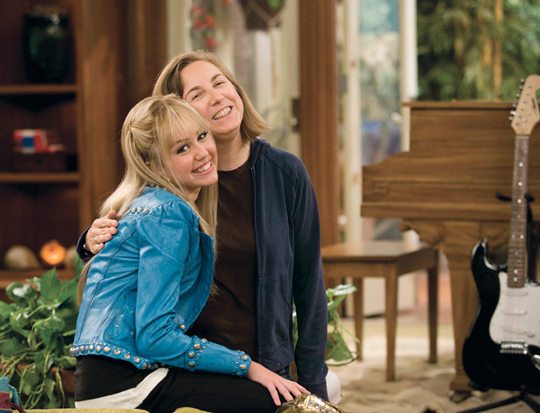 2nd AD Annie Simmons with Miley Cyrus on Hannah Montana.
2nd AD Annie Simmons with Miley Cyrus on Hannah Montana.
(Credit of Disney Channel/Joel Warren)
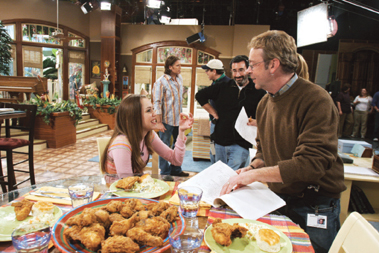
2nd AD Ron Paul (in black) gets Miley ready for a scene on
Hannah Montana. (Credit: Disney Channel/Byron Cohen)
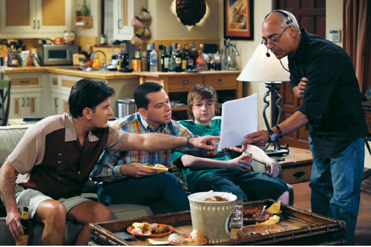
1st AD Mark Samuels preps Charlie Sheen, Jon Cryer an Angus T.
Jones on Two and a Half Men.(Credit: Greg Gayne/Warner Bros)
Even the most experienced AD, however, can't anticipate nature. When Tequan broke out in a bad case of adolescent acne on Everybody Hates Chris, Rhodes conferred with the director and had to call in makeup and lighting. And when Imani turned 14, her developing curves didn't jibe with her character, who was supposed to be younger. And the actress said that she didn't want to wear baby clothes anymore. So last season, producers took her out of pinafores and allowed her to wear more grown-up outfits.
Meanwhile, teens on series often pull the same kind of stuff they do at home. There are practical jokes, skateboarding across the stage, disappearing, running off to play video games or watch Family Guy and nonstop texting. "We let them blow off steam," Paul says of his cast. "If it's too claustrophobic you won't get the performance you want."
This kind of ongoing involvement makes for close relationships between child actors and the 1st and 2nd ADs they get to know so well. They're friends, supportive aunts and uncles and confidantes. So it was Mark Samuels, 1st AD on CBS' Two and a Half Men, who explained to 15-year-old Angus T. Jones (who plays Jake Harper) the mechanics of kissing for an episode last season. "I told him where to put his arm and how. No one else was offering to explain to him how to do it," says Samuels, who has worked with Angus since he was 8. When the series began, it was Samuels who stood behind Angus backstage to cue him on how and when to make an entrance. "When they're very young you really bond with them," he says. "Then when they reach their teens they tend to move away and rebel, just like in a relationship with a parent."
Like Samuels, many of today's ADs have previously worked on shows featuring children. Samuels honed his kid skills on the sitcom Roseanne, where he used to whisper lines into the ear of then-4-year-old Michael Fishman, who played D.J. The challenge—and what makes these ADs so good at their jobs—is to strike a balance between professionalism and recognition that these are children. They want to have fun—and often work better if they have fun—but also have to do their jobs. "You try to let the humor arise without letting it get out of control or they will sit there and laugh all day, and you will have nothing in the can," says Rhodes. "But you can't put the kabosh on everything fun because something creative may come out of it. The problem with kids on a single-camera show like Everybody Hates Chris, is that every minute you let them go on is another minute of school you miss and another minute out of their workday. You have 9.5 hours and nothing on God's green earth will change that because they're all under 16."
Even when the actors are consummate pros, every AD in the business has a story to tell about a pushy, crazed stage parent who hovers like a vulture, stands behind the camera and yells instructions to their child. On the first season of Everybody Hates Chris, unbeknownst to Rhodes, the director, and the show's producers, Imani's father was acting as her "coach." He would critique her after every scene, and she would come up with dramatic choices that were off the wall for a 12-year-old girl. "We went to her father and told him she was crying in the bathroom and we didn't know why," says Rhodes. "Then we found out what was going on."
To use a well-worn cliché—but one that still holds true—it's all in a day's work for ADs who adeptly and masterfully handle the child actors who pepper the landscape of network and cable television. They are sensitive and savvy professionals who understand that the immature minds and tender hearts of children require special handling and often-creative solutions. And Capps eventually figured out a way to convince Conner to put on that Cinderella costume in According to Jim. Teaming up with the show's wardrobe designer, they came up with two extra Cinderella costumes and convinced Conner's grandfather and older brother—both of whom were on the set that day—to put them on to send the message to the kid actor that it was okay. It worked, and Conner finally deigned to dress up as Cinderella. At the end of the day, all three got to take the costumes home. Better yet, the scene was shot and the episode was in the can.